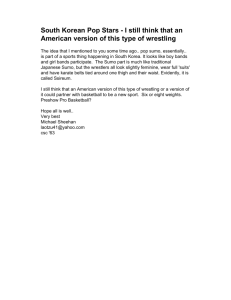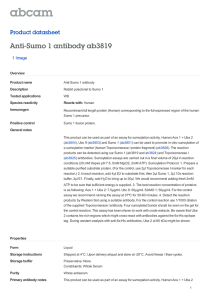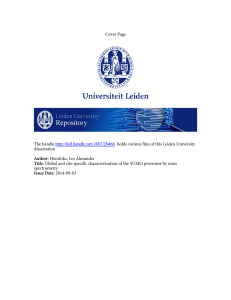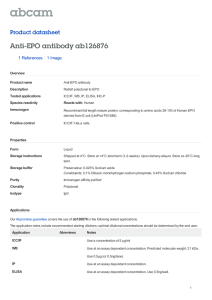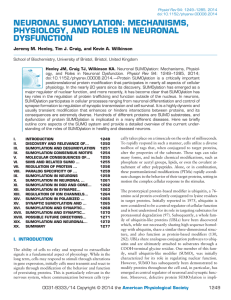ab139470 SUMOylation Assay Kit Instructions for Use
advertisement
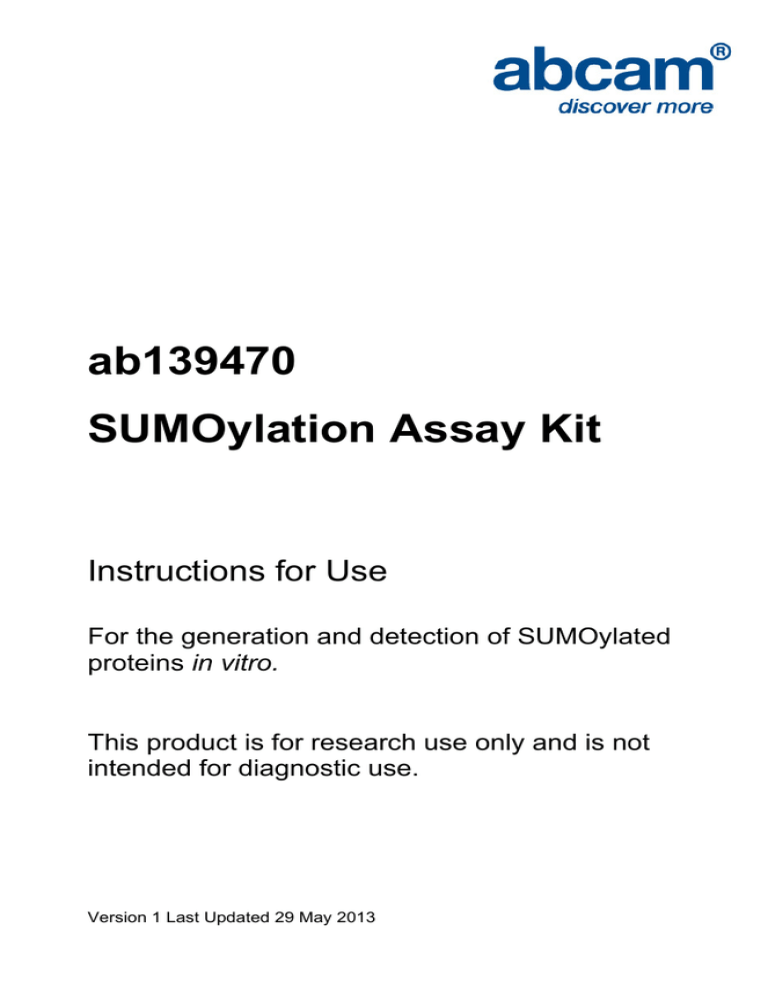
ab139470 SUMOylation Assay Kit Instructions for Use For the generation and detection of SUMOylated proteins in vitro. This product is for research use only and is not intended for diagnostic use. Version 1 Last Updated 29 May 2013 1 Table of Contents 1. Background 3 2. Principle of the Assay 5 3. Protocol Summary 7 4. Materials Supplied 8 5. Storage and Stability 9 6. Materials Required, Not Supplied 10 7. Assay Protocol 11 8. Data Analysis 17 2 1. Background Small ubiquitin-related modifier (SUMO) is a member of a family of ubiquitin-like proteins that regulates cellular function of a variety of proteins. Four members of the SUMO family have been described in vertebrates: SUMO1, the close homologues SUMO2 and SUMO-3 with some 50% homology between SUMO1 and SUMO2/3 and SUMO4. Tissue-specific SUMO4, identified in human kidney, bears homology to SUMO2/3 and variants of SUMO4 may be associated with susceptibility to Type I diabetes. Although having fairly low amino acid sequence identity with ubiquitin, the SUMO enzymes exhibit similar tertiary structures. The mechanism for SUMO conjugation is analogous to that of the ubiquitin system, relying upon utilization of E1, E2 and (potentially) E3 cascade enzymes. Unlike ubiquitinylation, which leads, inter alia, to a degradative pathway, SUMO modification of target proteins is involved in nuclear protein targeting, formation of sub-nuclear complexes, regulation of transcriptional activities, and control of protein stability. For example, SUMO modification of p53 represents an additional regulator of p53 tumour repressor protein stability and may contribute to activation of the p53 response. A short sequence containing the consensus Ψ-K-X-D/E (where lysine is the modified amino acid, Ψ is a large hydrophobic residue and X is any amino acid residue) is thought to be necessary for protein SUMOylation to occur. 3 SUMO activating enzyme (E1) is a heterodimeric complex consisting of Aos1 and Uba2. Aos1 is similar to the N-terminal half of the E1 enzyme for ubiquitin whilst Uba2 has similarity to the C-terminal half, and contains the active site cysteine residue required for formation of thioester bonds. However, Uba2 alone is not sufficient to catalyse SUMOylation. Ubc9, the only SUMO E2 enzyme, conjugates activated SUMO (but not ubiquitin) and mediates its subsequent linkage, via C-terminal isopeptide bond formation, to a number of proteins, including RanGAP1, SP100, p53, IκBα and PML, without the absolute requirement for an E3 ubiquitin-protein ligase-like activity, at least in vitro. Several enzymes have been shown to possess SUMO E3 ligase-like properties that allow/enhance the SUMOylation of specific target proteins under certain conditions in vitro. For example PIAS1 (protein inhibitor of activated STAT1) functions as a SUMO ligase toward p53, or possibly as a tightly bound regulator of it. The nucleoporin RanBP2 (a component of the nucleocytoplasmic transport machinery together with SUMOylated RanGAP1) also has SUMO E3-like activity. RanBP2 directly interacts with the E2 enzyme Ubc9 and has been shown to strongly enhance SUMO transfer to SP100 but not to p53. The ability to confer substrate specificity is a hallmark of E3 ligases. 4 The importance of the role these apparent E3 ligases play in the in vivo SUMOylation of proteins remains to be fully elucidated. 2. Principle of the Assay Abcam SUMOylation Assay Kit (ab139470) provides a means of generating SUMOylated proteins in vitro, by covalent linkage of the carboxy-terminal of SUMO1, 2 or 3 to specific lysine residues on the target protein via isopeptide bonds, using the SUMOylation enzyme cascade. A control target protein is provided together with all other necessary components. SUMO specific antibodies are provided for detection of SUMOylated proteins via SDS-PAGE and western blotting. This kit provides sufficient material for 20 x 20 μL reactions. Suggested uses for this kit include: 1) SUMO-modification of specific proteins in vitro. Allow investigation of the effect SUMOylation has on enzyme function, stabilization, protein:protein interactions and, hence, it’s role in regulation of cellular processes, such as the p53 tumor repressor and NF-κB pathways. 2) Demonstrate novel proteins are potential targets for SUMOylation under in vitro conditions. Starting point for examining the role SUMOylation of a protein might play in vivo. 5 3) Generate substrates for deSUMOylating enzymes, such as SENP1 and SENP2. 4) Test proteins for SUMO E3 ligase activity: does it facilitate or enhance SUMOylation of specific target proteins, particularly under conditions/enzyme concentrations that more closely represent those in vivo. 5) Addition of known SUMO E3 ligase to facilitate/enhance target protein conditions/enzyme SUMOylation, particularly concentrations that more under closely represent those in vivo (e.g. RANBP2, shown to be a ligase for SP100 SUMOylation). 6) SUMOylation of proteins in cell lysates or crude fractions/preparations to facilitate investigation of their role/function in complex solutions. 7) Demonstrate SUMOylation of known proteins in specific lysates (confirm with target protein specific antibodies). 8) Use of cell lysate or crude fractions/preparations as source of SUMO E3 ligases to facilitate SUMOylation of purified target proteins in the presence of SUMOylation kit components. 6 Note: Protocol provided for application 1. Assay set-up can be readily modified for alternative applications by inclusion, omission or substitution of specific components. 3. Protocol Summary Combine assay reagents. Mix thoroughly Incubate at 37°C for 1 hour Quench assays with 2X Non-reducing gel loading buffer Analyse by Western Blot 7 4. Materials Supplied Item Quantity Storage 20X SUMO Activating Enzyme E1 1 x 20 µL -80°C 1 x 20 µL -80°C 20X SUMO1 (Human, Recombinant) 1 x 20 µL -80°C 20X SUMO2 (Human, Recombinant) 1 x 20 µL -80°C 20X SUMO3 (Human, Recombinant) 1 x 20 µL -80°C 10X SUMOylation Buffer 1 x 40 µL -80°C 1 x 20 µL -80°C 20X Mg-ATP Solution 1 x 25 µL -80°C SUMO1 Rabbit Polyclonal Antibody 1 x 25 µL -80°C SUMO2/3 Rabbit Polyclonal Antibody 1 x 25 µL -80°C 20x Ubc9 (SUMO E2) (Human, Recombinant) 20x RanGAP1 Fragment (Human, Recombinant) 8 5. Storage and Stability All kit components should be stored at -80°C to ensure stability and activity. Avoid multiple freeze/thawing. If precipitation observed upon thawing 2x Non-reducing Gel Loading Buffer, warm tube at 37ºC for 5-10mins until solution clears 9 6. Materials Required, Not Supplied Eppendorf tubes 2x SDS-PAGE gel loading buffer (e.g. 0.25M Tris-Cl, pH 6.8, 4% SDS, 10% glycerol, 2% β-mercaptoethanol, 0.01% bromophenol blue). For Western Blot Analysis SDS-PAGE Gels (User prepared (12% standard / 4-15% linear gradient) or pre-formed. Pre-stained SDS-PAGE molecular weight markers PVDF membrane Anti-rabbit IgG secondary antibody (HRP linked) e.g. Goat polyclonal secondary antibody to rabbit IgG-H&L (HRP) (ab97051) (If required) Target protein specific primary antibody (user supplied) and appropriate secondary antibody-HRP conjugate. Western blotting detection reagents PBS Solution. 1x PBS. PBS-T Solution. PBS containing 0.2% Tween 20BSA/PBS-T Blocking Solution. PBS-T containing 1% Bovine Serum Albumin (BSA) Note: TBS-T can be used as an alternative to PBS-T if required. 10 7. Assay Protocol A. SUMOylation Assay Assay described for the SUMOylation of purified target proteins and control RG1 protein in vitro. Note: Assay conditions tested/optimized for a range of target proteins, including p53 tumor repressor and interferon inducible protein SP100, but may require adjustment for alternative enzymes. The RanGTPase-activating protein RanGAP1, a key regulator of the Ran GTP/GDP cycle required for the bi-directional transport of proteins and ribonucleoproteins across the nuclear pore complex, was the first protein shown to be post-translationally modified with SUMO. RanGAP1 is provided as positive control for in vitro SUMOylation reactions. It is readily modified with all three SUMOs in the presence of SUMO E1, SUMO E2 and Mg-ATP to give a single mono-SUMOylated product. Standard assay set-up Note: recommended total reaction volume = 20 μL. *Adjust dH2O volume in accordance with available target protein concentration. A final assay concentration of 200nM is recommended as a starting point for target protein SUMOylation (e.g. use 4 μL of 1 μM target protein solution). 11 Component TargetSUMO Sample RG1-SUMO RG1-SUMO (–ve control) (+ve control) (–ve control) Volume (μL) dH2O 13* 12* 13 14 2 2 2 2 20X Mg-ATP 1 - 1 - 20X SUMO E1 1 1 1 1 20X SUMO E2 1 1 1 1 10X RG1 - - 1 1 *Target protein X X - - 20X SUMO 1/2/3 1 1 1 1 10X SUMOylation buffer Negative control reactions omitting Mg-ATP cofactors demonstrate formation of auto-ubiquitinylated proteins is ATP dependent (required for E1 activation) and hence derived from the ubiquitin cascade. 12 Set-up assays/controls required (keep all enzymes on ice throughout) 1. Add assay components to 0.5mL Eppendorf tube(s) in order shown above. 2. Mix tube contents gently. 3. Incubate at 37ºC for 1 hour. 4. Quench assays by addition of 20 μL 2x SDS-PAGE gel loading buffer. 5. Proceed directly to “Western Blot Analysis” or store at -20ºC until ready. B. Western Blot Analysis Summary of analysis steps 1. Separate proteins by SDS-PAGE. 2. Western Transfer to nitrocellulose/PVDF membrane. 3. Block membrane with BSA/TBS-T solution. 4. Probe blot with either: a) SUMO antibody supplied or b) appropriate target protein specific primary antibody in conjunction with suitable secondary antibodies 5. Develop with western blotting detection reagents. Note: Do NOT use milk in blocking/antibody binding solutions. Please use 1% BSA in PBS or TBS Tween instead. 13 Example procedure for Western blotting Note: This protocol has been optimized using the materials indicated above. Using materials other than those listed may require additional optimization. 1. Apply ~10 μL of each quenched assay solution to the gel, alongside selected molecular weight markers, electrophorese and transfer protein to membrane according to standard procedures. 2. Remove membrane from the transfer unit and block membrane with BSA/PBS-T blocking solution for 1 hour at room temperature on a rocking platform, or overnight at 4ºC. Note: Drying PVDF membrane prior to blocking, as per Manufacturers’ instructions, may considerably enhance results. 3. Wash membrane for 3 x 10mins with PBS-T on a rocking platform. 4. Dilute required SUMO antibody (anti-SUMO1 or anti-SUMO2/3) 1/1000 in BSA/PBS-T. 5. Incubate membrane with SUMO antibody solution overnight at 4ºC on a rotor mixer. 6. Wash membrane for 3 x 10mins with PBS-T on a rocking platform. 7. Dilute appropriate anti-rabbit IgG secondary antibody (HRPlinked) according to the manufacturer’s instructions (e.g. 1:5000 in BSA/PBS-T). 14 Note: We recommend using Goat polyclonal secondary antibody to rabbit IgG-H&L (HRP) (ab97051). 8. Incubate membrane with secondary antibody solution for 1 hour at room temperature on a rocking platform, or as specified by the manufacturer. 9. Wash membrane for 6 x 10mins with PBS-T on a rocking platform. 10. Proceed to step 17. Specific target protein detection (if required) 11. Dilute appropriate target protein specific primary antibody according to manufacturer’s instructions. 12. Incubate membrane with target protein specific primary antibody solution overnight at 4ºC on a rotor mixer. 13. Wash membrane for 3 x 10mins with PBS-T on a rocking platform. 14. Dilute appropriate secondary antibody in BSA/PBS-T according to the manufacturer’s instructions. 15. Incubate membrane with secondary antibody solution for 1 hour at room temperature on a rocking platform, or as specified by the manufacturer. 16. Wash membrane for 6 x 10mins with PBS-T on a rocking platform. 15 Analysis 17. Prepare western blotting detection reagent according to the manufacturer’s instructions 18. Incubate membrane with detection reagent for appropriate time. 19. Detect emitted signal by luminography or CCD imaging instrument. 16 8. Data Analysis Example results for Western blotting Figure 1: Western Blot of SUMOylation Assays for RANGAP1 control target and SP100/p53 target proteins. Assays set-up and run as described in “Assay Protocol”. SUMOylated proteins were detected by Western Blotting on SUMOylation assays containing A: RANGAP1, B: p53 and C: SP100 target proteins with 1: SUMO1, 2: SUMO2 and 3: SUMO3 substrates using the appropriate SUMO antibody ubiquitinylation assays. Auto-ubiquitinylation assays set-up and run as described in “Assay protocol”. Results demonstrate the formation of SUMOylated target proteins of the expected size in all ATP containing reactions. The absence of such conjugates in –ve control reactions demonstrates that their 17 formation is ATP dependent (required for E1 activation) and hence derived from the SUMO cascade. Note: Presence of band in 36kDa region of some –ve controls can be attributed to small amounts of di-SUMO substrate not E2SUMOconjugates (demonstrated by presence in control reaction omitting E2 and removal by treatment with 100mM DTT [results not shown]). 18 UK, EU and ROW Email: technical@abcam.com | Tel: +44-(0)1223-696000 Austria Email: wissenschaftlicherdienst@abcam.com | Tel: 019-288-259 France Email: supportscientifique@abcam.com | Tel: 01-46-94-62-96 Germany Email: wissenschaftlicherdienst@abcam.com | Tel: 030-896-779-154 Spain Email: soportecientifico@abcam.com | Tel: 911-146-554 Switzerland Email: technical@abcam.com Tel (Deutsch): 0435-016-424 | Tel (Français): 0615-000-530 US and Latin America Email: us.technical@abcam.com | Tel: 888-77-ABCAM (22226) Canada Email: ca.technical@abcam.com | Tel: 877-749-8807 China and Asia Pacific Email: hk.technical@abcam.com | Tel: 108008523689 (中國聯通) Japan Email: technical@abcam.co.jp | Tel: +81-(0)3-6231-0940 www.abcam.com | www.abcam.cn | www.abcam.co.jp 19 Copyright © 2013 Abcam, All Rights Reserved. The Abcam logo is a registered trademark. All information / detail is correct at time of going to print.
